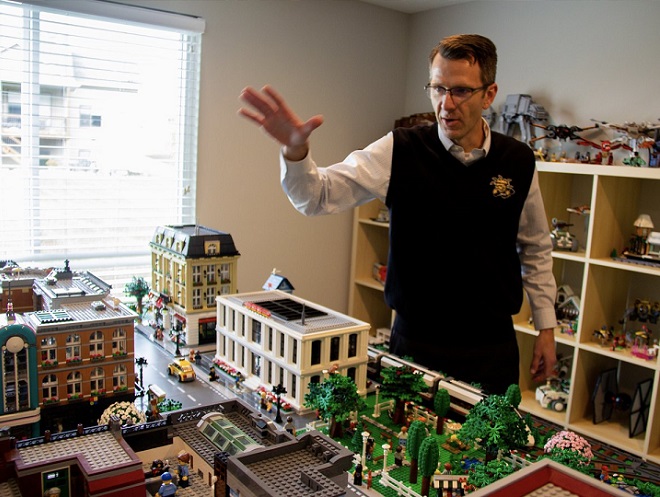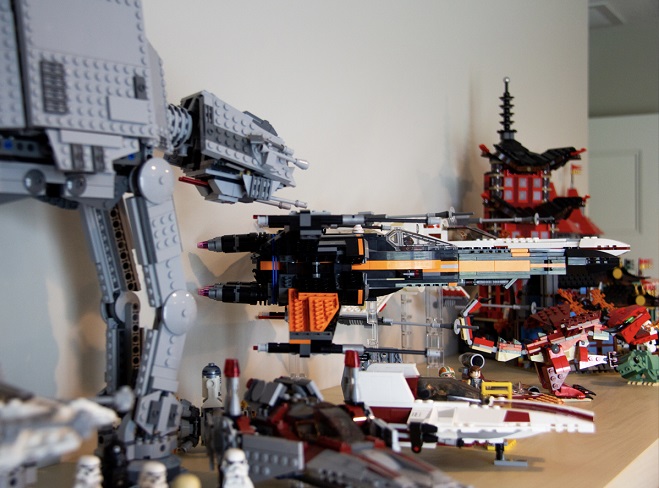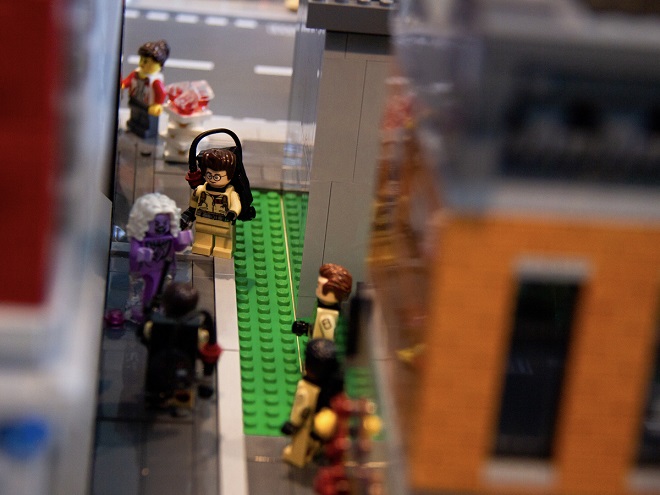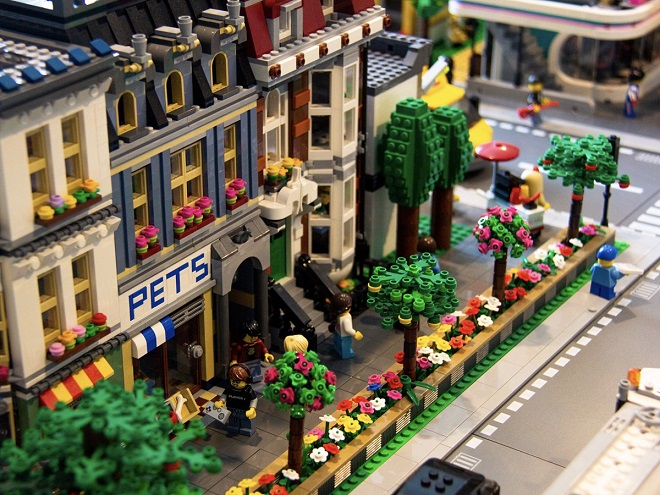Communications of the ACM
Engineering Dean Gets Creative With His LEGO City

Dennis Livesay, College of Engineering dean at Wichita State University, overlooking the city hall of his LEGO city.
Credit: Wichita State University
In pictures, it looks like a real city in still-life.
Inside a street-side sushi bar, residents enjoy California rolls while off-duty staff scarf down hot dogs in the alley just outside. A small girl scowls at the concrete, staring at the melting ice cream she just dropped from her empty cone. A navy sailor returns home from deployment and walks into the bustling Union Station. Behind him, a diesel engine roars by a crowd of waiting travelers.
In reality, it's a 75-square-foot custom LEGO city on a table.
Dennis Livesay, dean of the College of Engineering, has constructed the city in his basement during the last six years. Most of it is his own creation.
"I focus a lot on telling little stories, creating the city I want to live in. In my head, everything has a backstory that you wouldn't know unless you talked to me and had me explain it," Livesay says.
The city has a long history stemming from his childhood. "I played LEGOs as a kid, and at that point, I was collecting 'Star Wars' LEGOs, so I had that in the back of my mind," he says.
Livesay and his wife, Lauren Beastall, went to Balboa Park, Calif. in 1998. They visited a train museum which had a LEGO city much like what Livesay has now. That city helped Livesay envision his own, which he began constructing in 2013.
A third of his city today is comprised of purchased sets. The other two-thirds are what Livesay and other LEGO enthusiasts call MOCs, short for "my own creations."
All of the buildings have their own flavor. Livesay is proud of his newest addition, the city's early 20th-century Union Station. The station contains a travel agent, which Livesay admits is quaint today.
"I think about buildings and the way they evolve. Union Station was built at the turn of the century — probably post-World War I or pre-World War II — and has evolved."

The main boulevard is a source of pride. Livesay wanted it to be lush and idyllic.
"I originally had the vision of a boulevard with a median," he says. "but they don't sell these plates with a median, so I put the foliage on the sides."
The city hall lies at the end of the boulevard, and at its front steps stand minifigures representing Livesay's wife, his son, and himself. He's holding a Diet Coke, his favorite drink.
The city wouldn't feel alive without an active population. It's filled with stories and diverse characters represented through the minifigures and their careful poses. One minifigure marching down the street has an afro hairstyle and a disco suit; which Livesay likens to Disco Stew from "The Simpsons." "I think that's actually a woman, so she's Disco Stella or something," he says.

One of the most obscure references in the city is a dark-haired minifigure in pajamas, sitting in a wheelchair, staring out of his second-floor window with a spyglass. It's a little hard to see through the tinted glass.
It's a reference to Alfred Hitchcock's film "Rear Window" starring Jimmy Stewart. "He breaks his leg and someone buys him a pair of binoculars so he can keep himself occupied," Livesay says. "He sees a crime occurring outside of his rear window, so that's my 'Rear Window' homage."
Below Jimmy Stewart, Santa Claus sits on a couch with a TV remote in hand. Santa can relax . . . it's not Christmastime yet.
Livesay strives to make his city diverse, but due to the lack of diversity in minifigures it can be a struggle. Most of them bear the original, neutral LEGO yellow.
"It was an issue for Lando Calrissian — how are they going to do it for 'Star Wars?'" Dennis asks. "When they created the dark-skinned Lando figure, they also starting creating some figures with a pale, Caucasian flesh tone to distinguish race. There's not a lot, but I've added as much racial diversity as I can."
Lando from "Star Wars" holds the honor of being the first dark-skinned LEGO minifigure. Who knew?

When Livesay points out two women sitting on a park bench, he proves that LEGO diversity isn't limited to the color of the minifigure. They're one of several homosexual couples living in the city, he says.
The city is constantly evolving.
In a separate room, Dennis has a workstation on which he has a few initial design elements for a building to be built. It's currently only a single wall with a window, but the style is already distinct from other buildings in his city.
"To me this is a way of expressing creativity. It's very cathartic," Livesay says. "And, most importantly, it's something that I really enjoy."

No entries found